ADUs
Accessory Dwelling Units
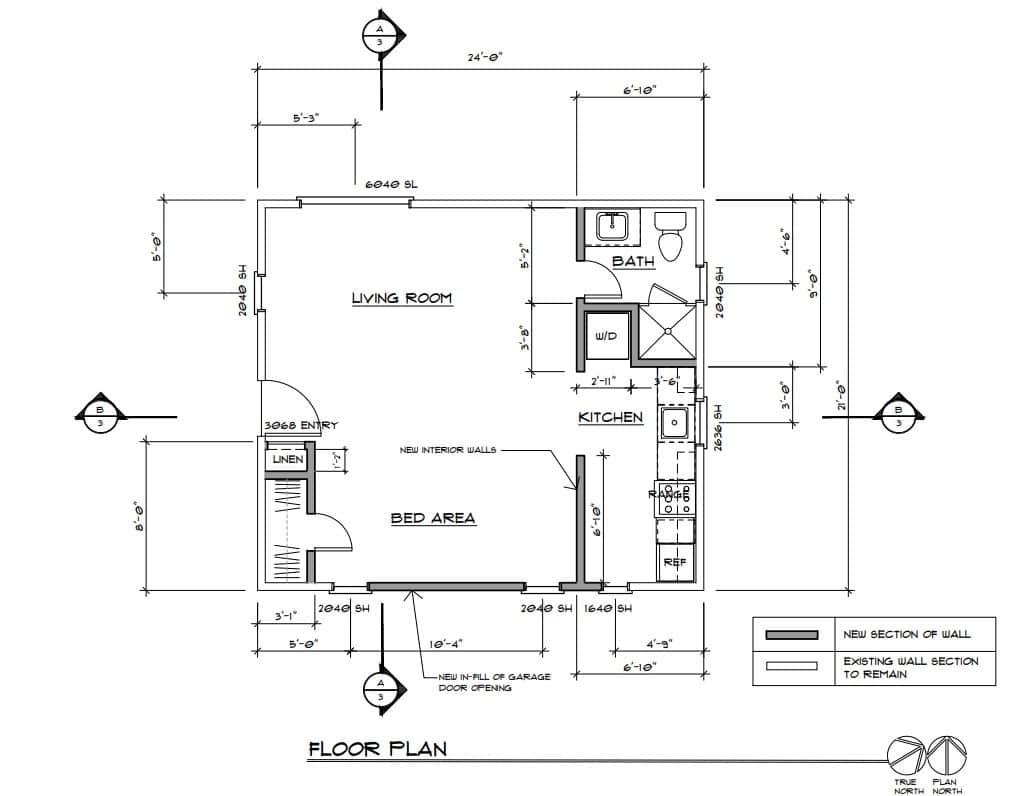
What is an ADU?
(Accessory Dwelling Units)
An ADU is an attached or detached Residential Dwelling Unit that provides facilities for an independent life. It’s a unique opportunity to cover different housing needs. It offers an accessible solution for family, friends, the elderly, home health care providers, the disabled, or anyone else who needs a place to reside. It can be placed in a lot that is within the permitted areas and has a pre-existing residence. Surely you’ve heard before about ADU’s. Still, it is often called grandma’s flat, guest house, studio apartments, or mother-in-law apartments with another name. By law, ADU’s must always be placed in the same lot as the existing single-family residence.
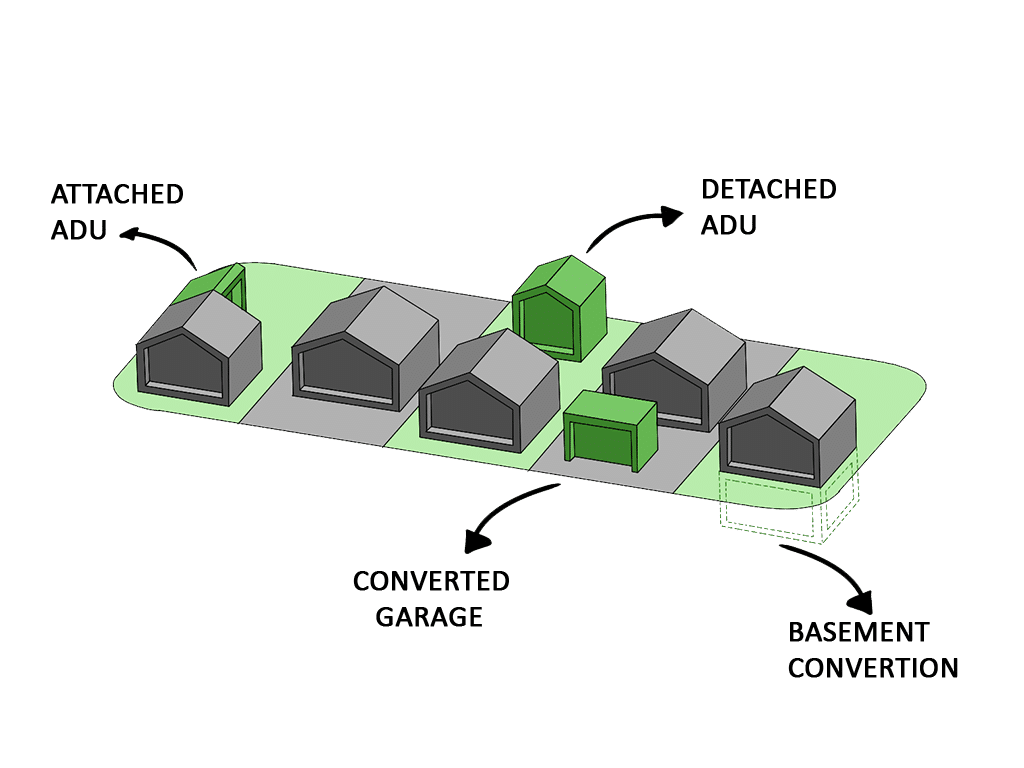
An ADU can be detached, attached, become part of the primary residence (converting a space), or a garage conversion (attached or detached). An accessory dwelling unit provides everything necessary for the living; sleep, eat, cook, and sanitation. ADUs are independent of the primary residence, and also, they do not have access to it. ADUs cannot be sold separately. In summary, these are entirely independent housing units that can be added to almost any Residential property.
Eligibility
Where is an ADU allowed?
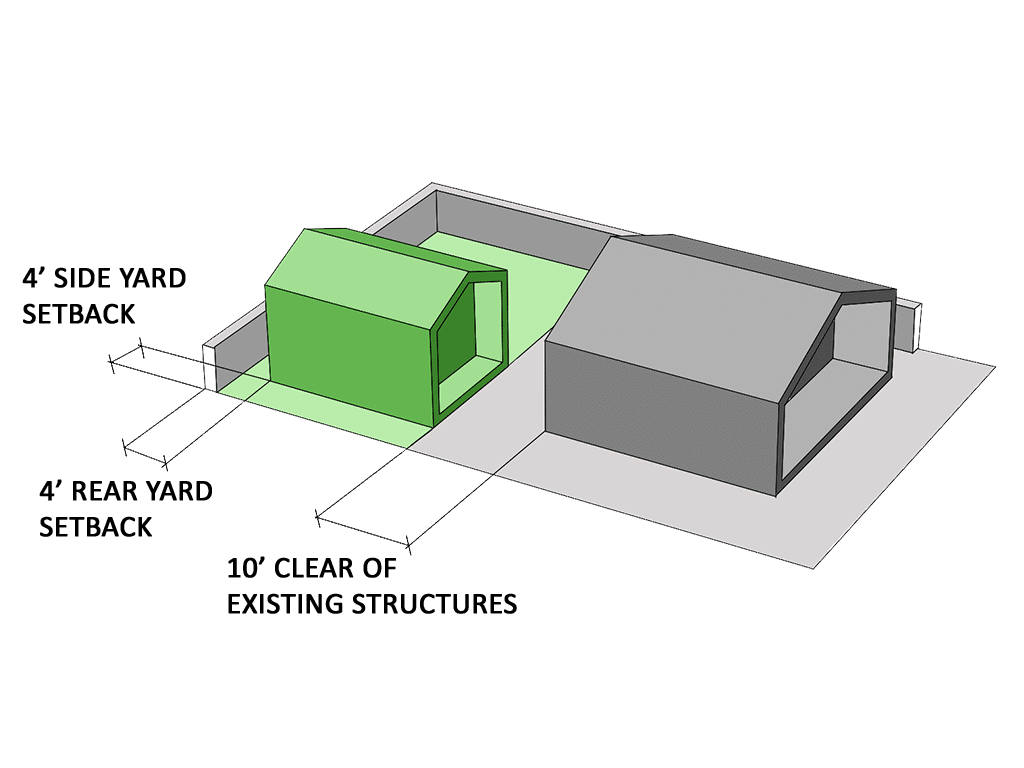
What are the setbacks for an ADU?
These are the spaces required by law that must be left when building a new ADU. Front, exterior, and side yard setbacks, the rear and side setbacks should be at least 4 feet.
Existing garages, carports, and other pre-existing accessory structures do not require a 4 feet setback. They can keep on their current setbacks as long as the existing structure is converted or removed and replaced with a new ADU in the same location.
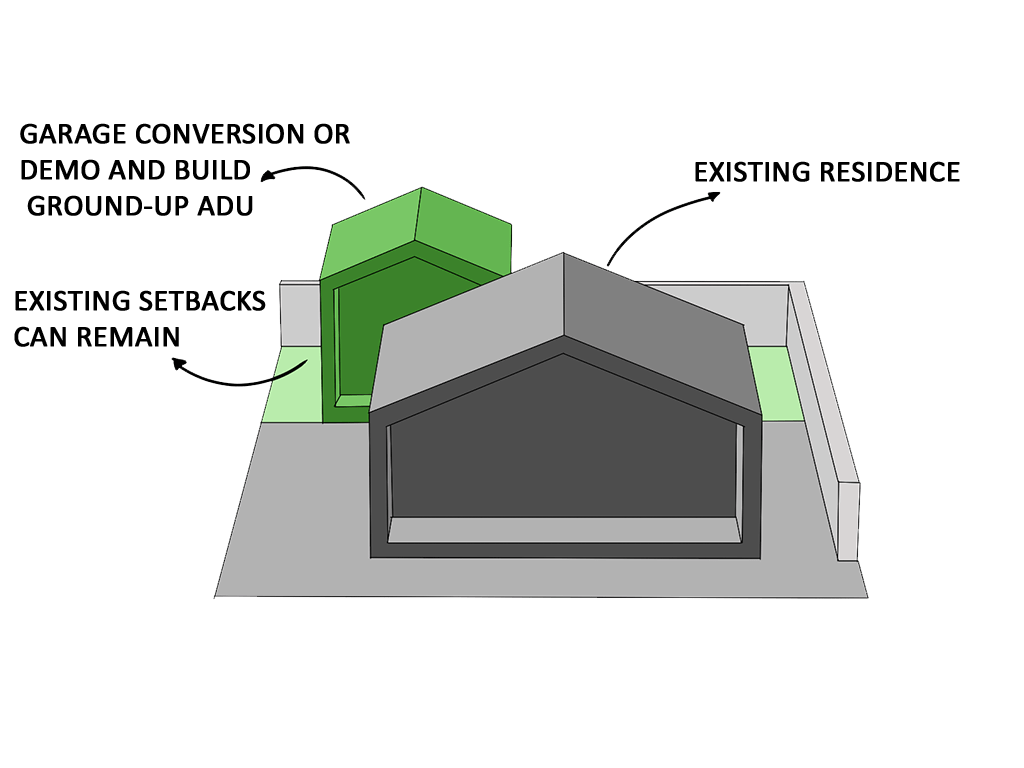
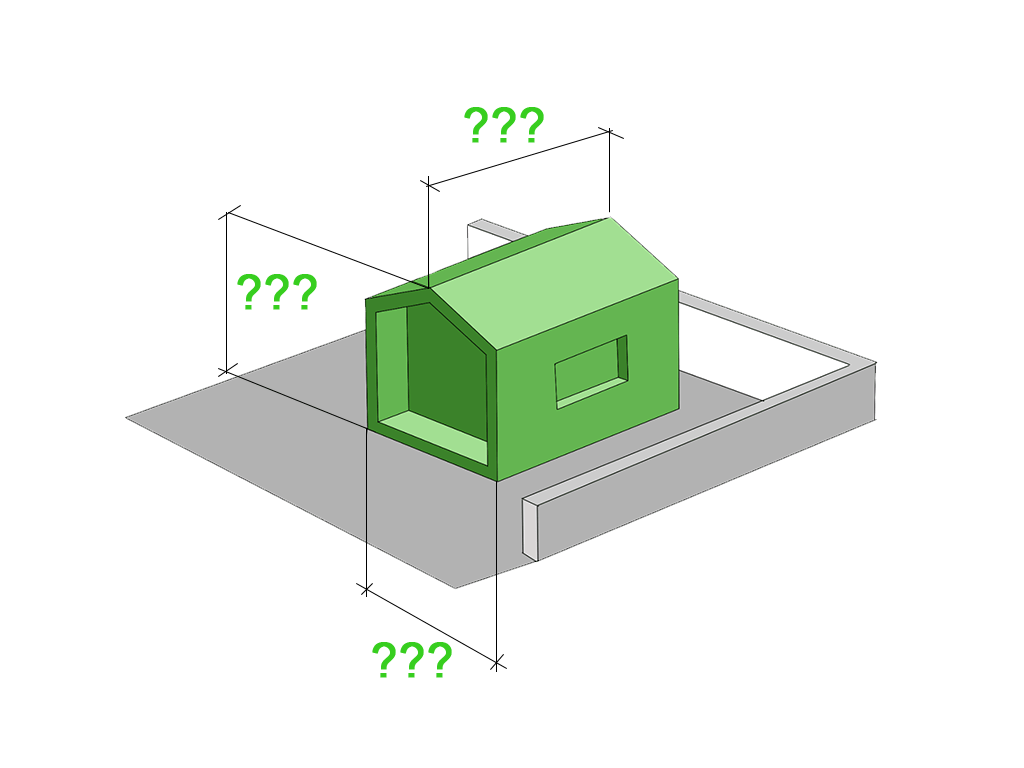
Dimensions
What size ADU is allowed? How big?
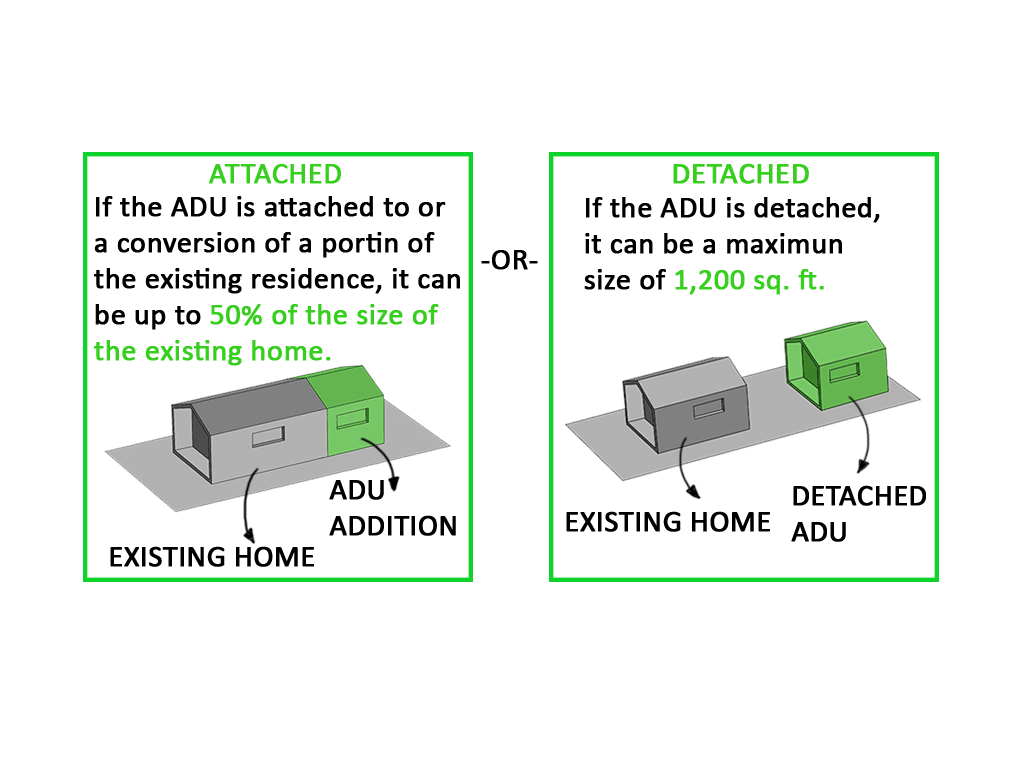
As part of the 2020 ADU rule updates, all cities must now permit the following three types of ADUs without applying any local standards such as lot size, height, setbacks, unit size, or lot coverage.
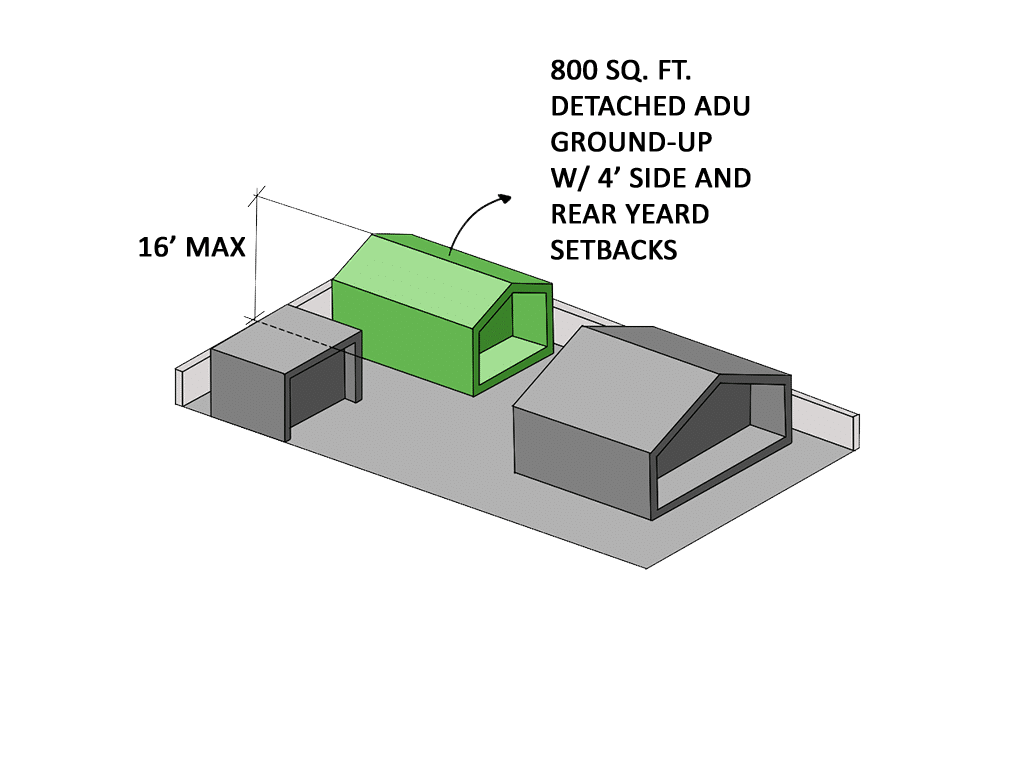
1. New 800 sq. ft. max 16’ detached ADU with max height and 4’ side and rear yard setbacks.
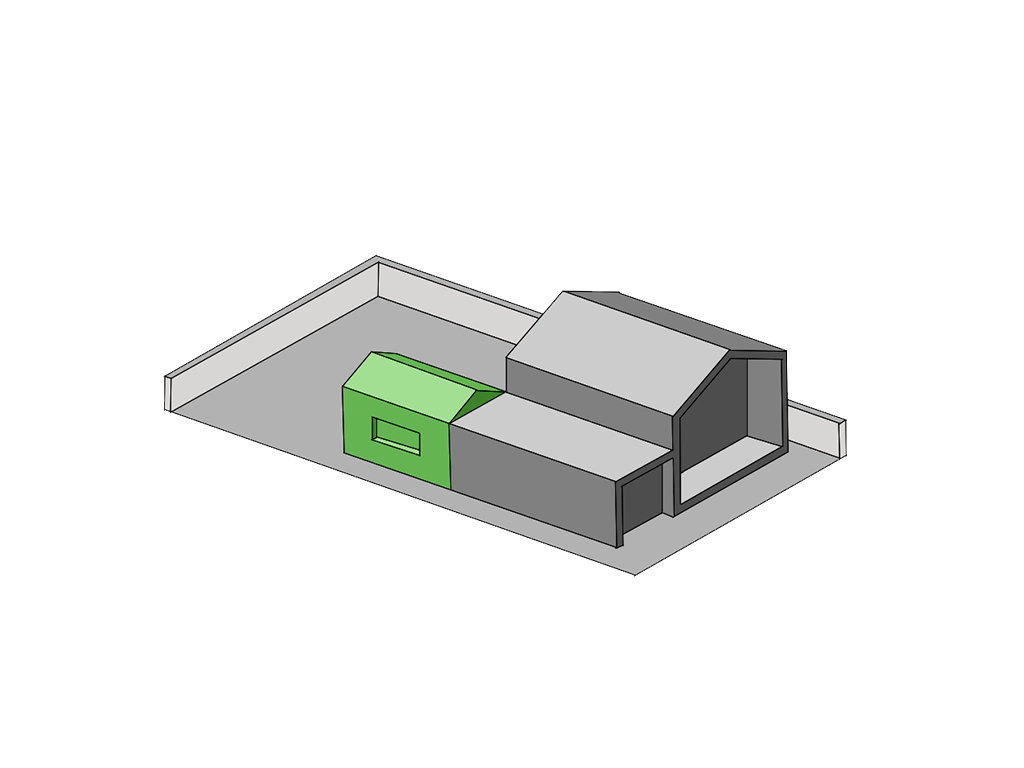
2. ADU created by converting an existing space
in the main residence.
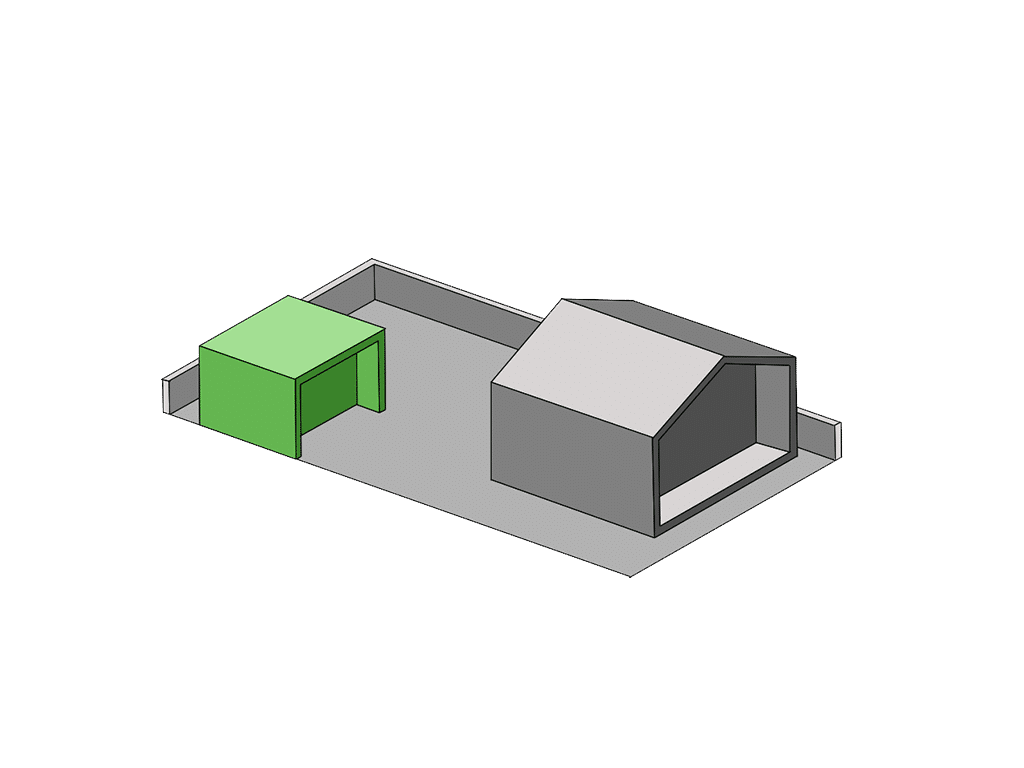
3. ADU created by converting an existing
garage or carport.
Parking and access
Is Additional Parking Needed For an ADU?
Suppose the property is located half a mile from public transportation. In that case, it does not require additional parking. However, it may be necessary to maintain the parking spaces for the existing residence.
The minimum dimensions of the parking space must be maintained when considering relocating parking spaces if required.
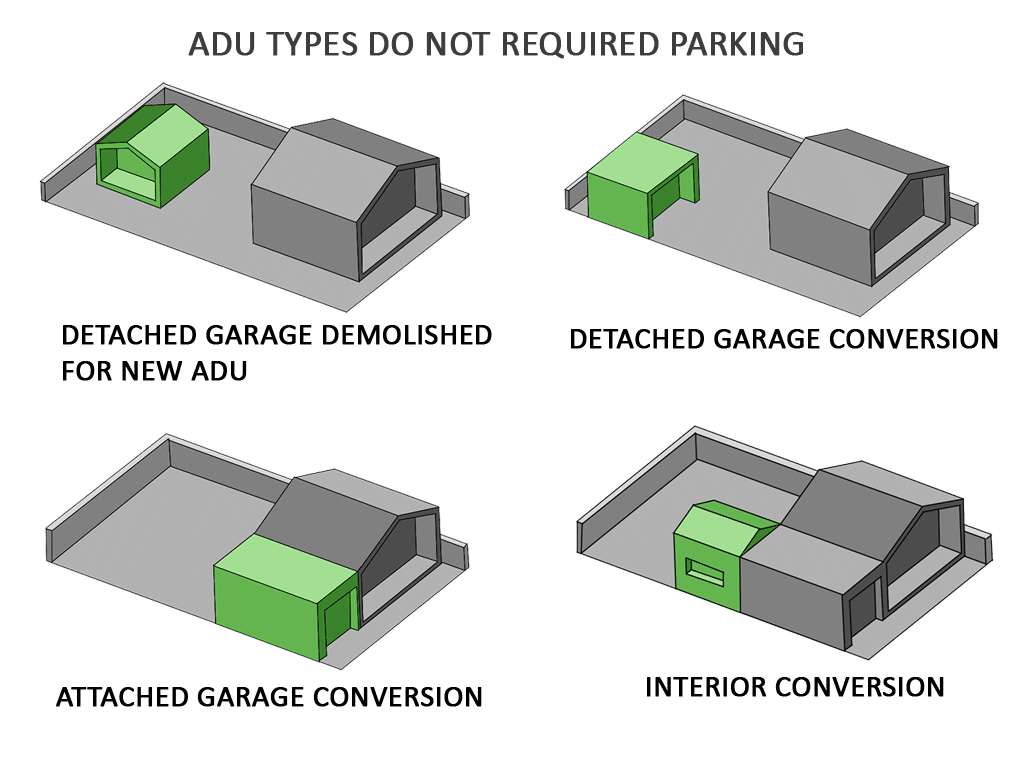
Parking
If the ADU is to be built after demolishing or converting a garage, it does not need to replace parking spaces. If you wish, it is possible to park the vehicles inside the setbacks; This means that your driveway can be used for parking. On the contrary, if you are not demolishing or converting a garage, the parking lot may not be located in the front setbacks. But if you have a corner lot or a rear Alley lot, you could add another driveway or use the same alley as a backup parking space.
Pedestrian
In this case, all ADUs require pedestrian access through a path to walk on. The code requires that walking trails be at least 3 feet wide throughout the entire distance of the route and that if there is some structure, the space at the height of people’s heads is not less than 7 feet. The path should lead from the ADU entrance to the front yard, sidewalk, or other public passage. The existing driveway can serve to comply with these regulations, or you can add a path to the side yard.
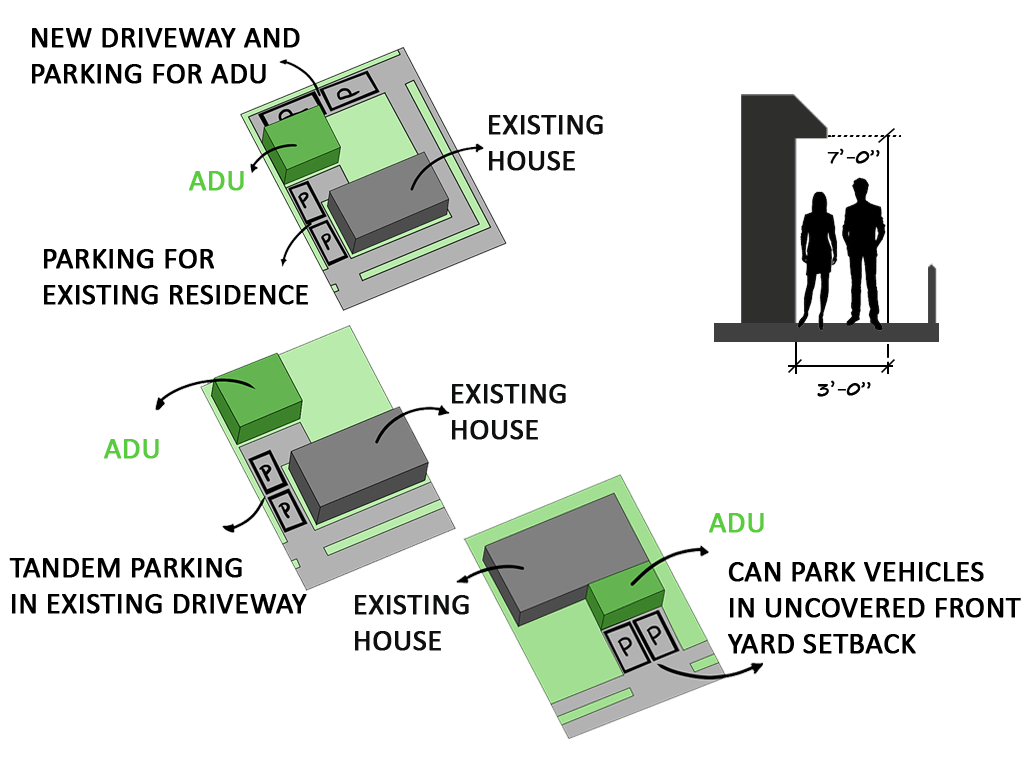
Location
Best Lots On to Which To Build An ADU
Although lots in California properties come in many shapes and sizes, we believe that some standard and essential features could help determine the best way to locate an ADU on them. Being creative, in almost every property that we have, a single-family home, we could use the design to fit an ADU on the same lot properly. However, what makes the difference in the success of a project is recognizing the maximum potential regarding the type of ADU that best suits each particular lot.
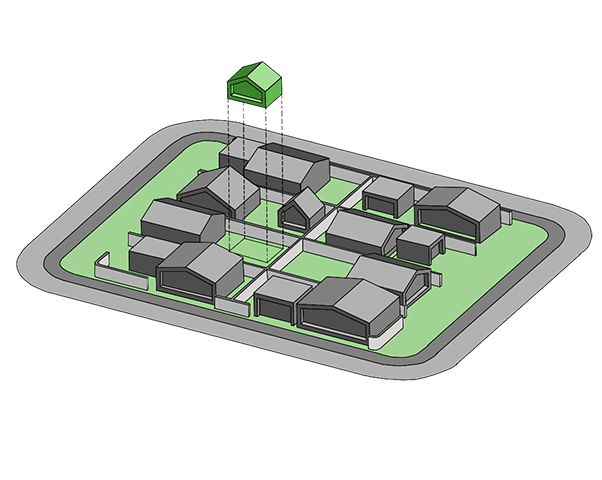
Corner Lots
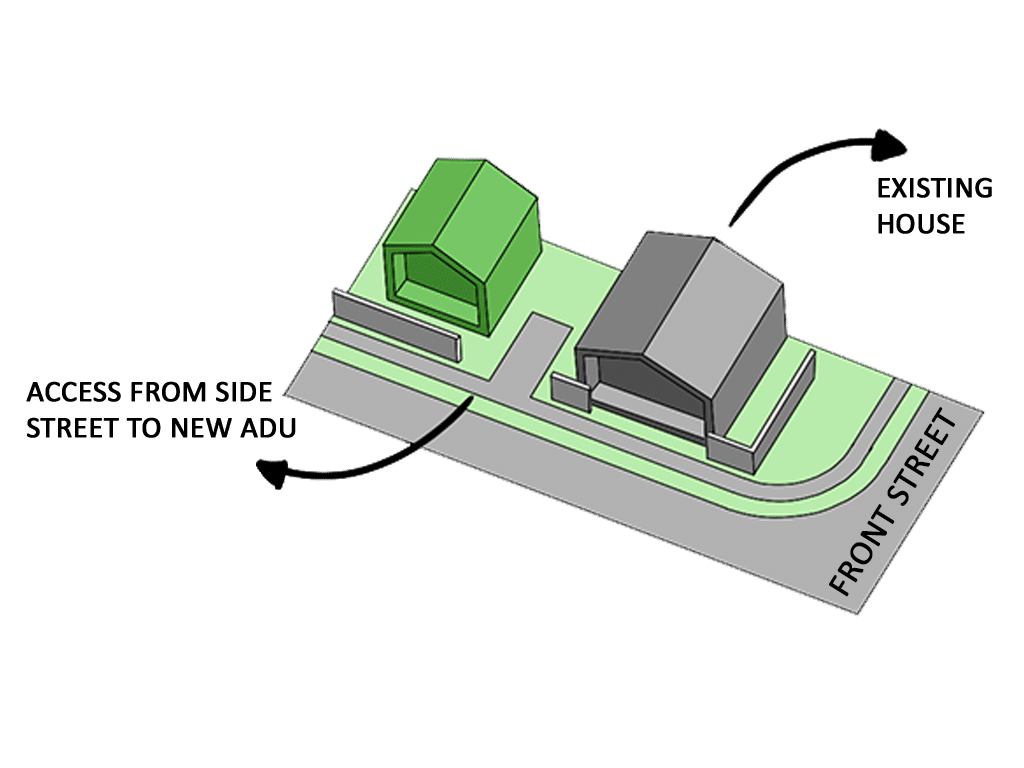
Corner lots provide easy access and the possibility of flexible driveway design.
If the ADU front the side road, it would be possible to make an additional cut-off and a separate driveway for the unit.
Infill Lots
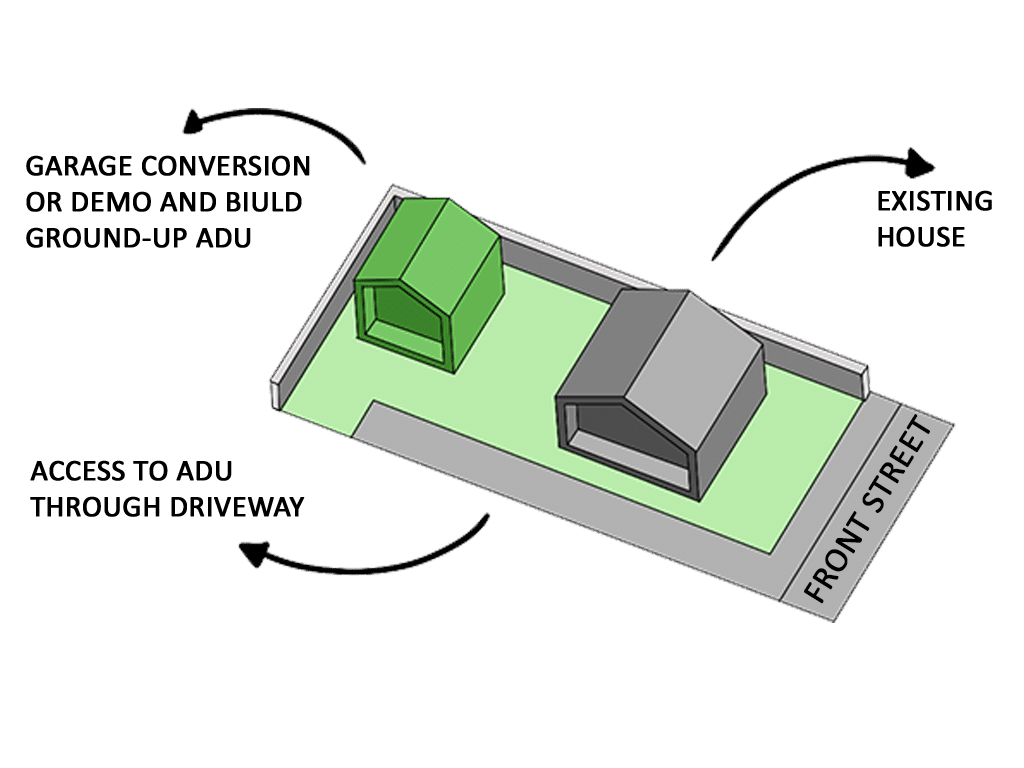
Infill lots are the most common to find with neighbors on all three sides. The existing driveway can be used to access the new unit.
If, when building or converting the garage, you ended up eliminating the parking space. Despite not being required, the cars could be parked in tandem along the driveway.
Rear Alley Lots

An alley lot offers direct access to the new unit from the rear of the property.
Half of the distance of the alley width counts towards the rear setbacks, which would result in a distance of cero feet setback at the rear. However, this is different if the new unit has two-story.
Parking spaces can be provided outside the alley, adjacent to the new unit, and on the side yard setbacks.
You could also choose to add a fence between the primary residence and the new unit to give both units more privacy.
ADU or JADU…
What is a JADU
Junior Accessory Dwelling Unit
It is like an ADU, but it differs in some requirements we name below:
- The maximum size cannot exceed 500 square feet.
- Its structure must be added to the existing single-family dwelling. It may already be part of it and be converted, such as a garage or an existing primary residence room.
- In summary, the accessory structure must be attached to the main house.
- A 150 square feet expansion to the main house’s footprint is possible as long as it just accommodates the entry and exit for the new unit. Such an increase must maintain the rule of a total size of less than 500 square feet.
- JADU requires independent external access from the primary residence.
- No new parking is required for JADU if the attached garage is converted. In this case, a parking space must be provided to the primary residence.
- JADU can have a separate bathroom or share it with the main house.
- The kitchen must meet the requirements of being an “efficient kitchen,” this means that the sink must be a maximum of 16″ x 16″ and also must have a drain line of a maximum diameter of 1.5″. You cannot place appliances that require natural gas or propane gas, and food preparation counter and storage cabinets should be of a reasonable size in relation to the size of the JADU. Electrical appliances should be such that they do not require electrical service greater than 120 volts.
- It will be possible to build a home addition and then request that it become a JADU.
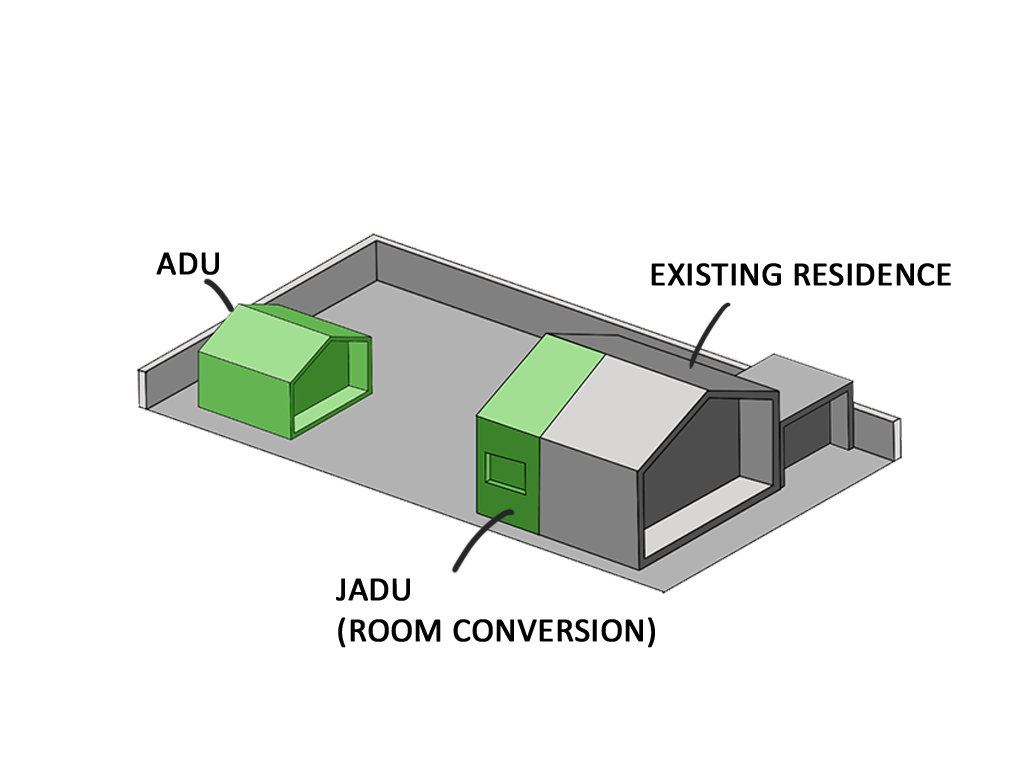
One of the most important changes in the ADU rules that came into effect in 2020 is a provision from California state bills AB-68 and AB-881 that allows to build both an ADU and a JADU in the same lot with a proposed or existing single-family house. It means that a homeowner can add two units on the same property.
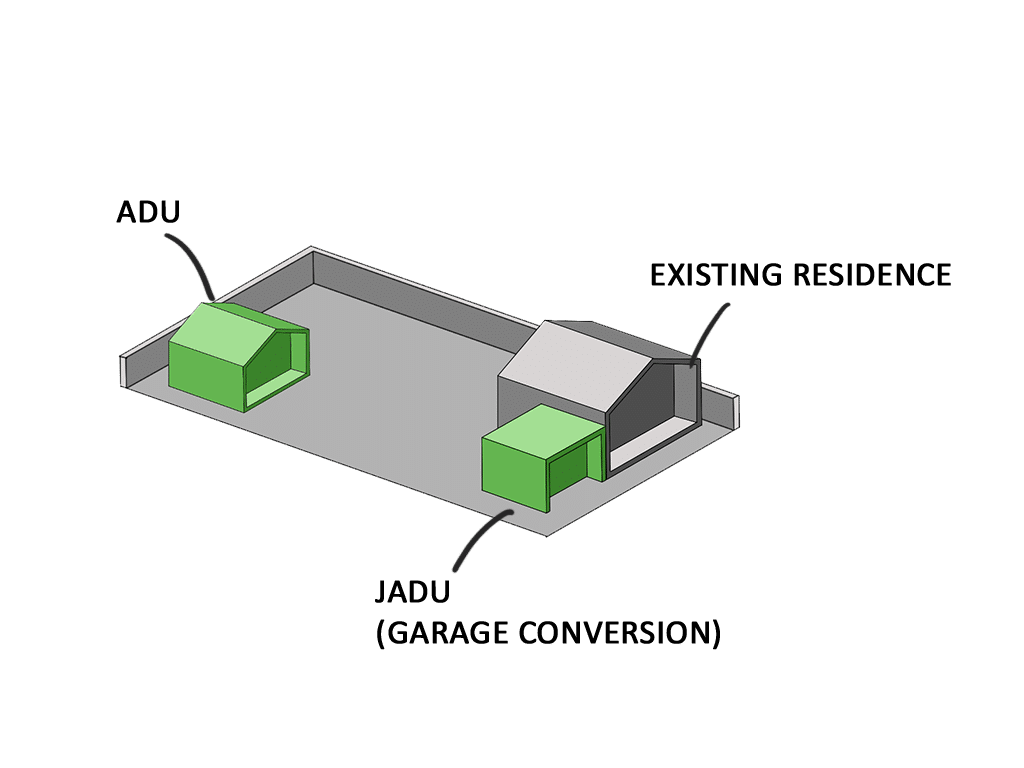
Can I rent the JADU?
You can put an ADU and a JADU on the same property and rent them both.
However, the occupation of the owner in one of the two units is required. Owner occupation will not be necessary if the owner is a government agency, land trust, or housing organization.
Is additional parking needed for a JADU?
No jurisdiction can require replacement parking for a garage conversion to an ADU or a JADU, according to Bill AB-68,
SEC. 2.
Section 65852.22 of the Government Code
(b) (1) An ordinance shall not require additional parking as a condition to granting a permit.
“please check with your particular city.”
See link for more information about California Legislative Information.
FAQs
It is necessary for the owner to live in the accessory unit?
No, anyone can live in an ADU.
It is possible to convert an existing accessory structure into an ADU?
Yes, any existing accessory structure can be converted into an ADU upon issuance of a building permit.
Can I attach a garage to my ADU?
Yes, it is allowed as long as the garage’s total floor area does not exceed 1000 square feet, provided in section 6156.g. For more information, it is advisable to view the previous section carefully. It will not be possible to attach other additional rooms to the ADU for any other use unless authorized by administrative permission.
Is there any height limitation for the ADU?
Yes, they are limited to 2 floors maximum and 24 feet tall, except for multi-family complexes.
Can I sell my ADU?
No, it cannot be sold separately from the existing single-family residence, and if rented, it cannot be for less than 30 days.
Is a Building Permit required for an ADU?
Yes, it will be required to ensure that the new living room complies with all zoning, construction, health, and safety codes.
Connections to public services are necessary?
Yes, they must provide the necessary public services such as water, sewer, or septic tank. Consult each service agency to obtain adequate information on their requirements for wearing permit processing.
ADU requires fire sprinklers?
These will not be required in some instances, but this determination may vary according to certain factors, such as the size and distance to a road from the ADU. Before investing in a project, it is advisable to discuss it with the appropriate fire department since these will determine the necessary fire protection services.
What’s Next?
Fill Out the Simple Form
Send us some basic info via the form below.
Schedule an Appointment
Use the link we send you to the email address you enter in the form and choose the day and hour of your preference to receive our call.
Get FREE Phone Consultation
Someone from our team will call you to speak more about your project and gather more information so we can accurately plan out how to start your project.
